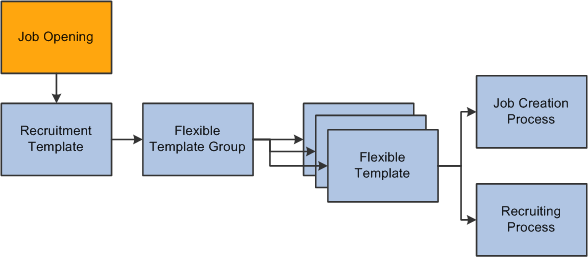Understanding Flexible Processes
Flexible processing refers to configuration options that let you set up role-based access to certain recruiting options. Different flexible process definitions can be applied based on a job opening’s business unit, job family, job code, department, and primary recruiting location. Limiting recruiters and hiring managers to context-appropriate and role-appropriate options improves usability and streamlines the recruiting process.
Note: Flexible processing restrictions do not apply to recruiting administrators.
Flexible Process Types
You can configure flexible processing rules for these two processes:
Job Creation Process
A flexible job creation process enables you to hide fields for job openings that are not yet open. This includes newly created job openings that have not yet been saved as well as jobs in Draft status. In general, this process is most useful for limiting which fields hiring managers see when they need to supply or review data for a new job opening. Showing the hiring managers only the relevant fields, without the distraction of the full set of job opening fields, reduces confusion and streamlines the hiring manager’s tasks.
Recruiting Process
Flexible recruiting processes include two types of rules:
Hide specified recruiting actions based on the applicant’s disposition. For example, if recruiters are the only users who should prepare job offers, you can hide the Prepare Job Offer action from hiring managers. You can also hide specific actions from both recruiters and hiring managers if those actions are not part of your business process.
Present a limited set of successor dispositions based on the applicant’s current disposition. This limitation applies when a user is manually updating an applicant’s disposition using the Edit Disposition action.
When setting up successor dispositions, the settings on the Status Successors Page affect which dispositions you can configure as valid successors. The flexible process settings (which actually prevent invalid transitions) then take precedence over the general status successor settings (which simply warn users when a transition is invalid).
Flexible Process Implementation
To implement flexible processing rules:
Create job creation process definitions.
Use the Job Creation Process Pageand the Configure Field Visibility Page.
Create recruiting process definitions.
Use the Recruiting Process Page, the Dispositions and Roles Page, and the Actions and Roles Page.
Create a flexible process template that associates your definitions with specific job criteria.
Use the Flexible Process Template Page.
Create a flexible process group that contains all of the flexible process templates that you want to associate with a single recruitment template.
Use the Flexible Template Group Page.
Associate the flexible template group with a recruitment template.
Use the Recruitment Template Page.
(Optional) Select default flexible processes to use when a job opening’s recruitment template does not find a flexible process based on the job opening data.
Use the Recruiting Installation - General Page
If you do not specify defaults, job openings that do not use flexible processing are unrestricted. Specifically:
When no job creation process is in effect, the system displays all job opening fields to all users during the job creation process.
When no recruiting process is in effect, the system does not restrict access to actions or to dispositions.
Image: Architecture for flexible processes
This diagram shows the architecture for implementing flexible processing. A job creation process and a recruiting process are associated with a flexible template. One or more flexible templates are associated with a single flexible template group. The flexible template group is associated with a recruitment template. When a job opening uses a particular recruitment template, it also uses the associated flexible process rules.
